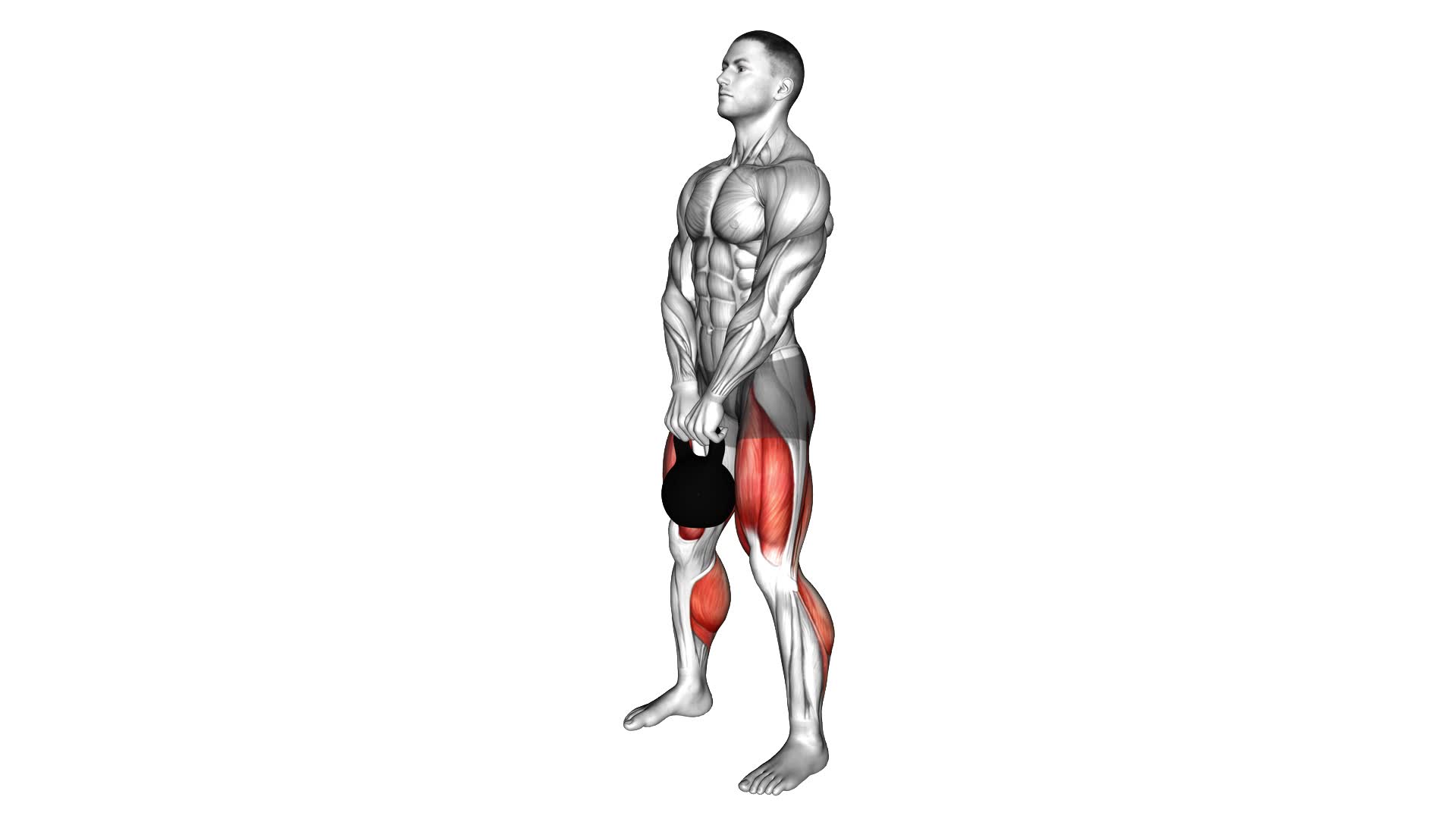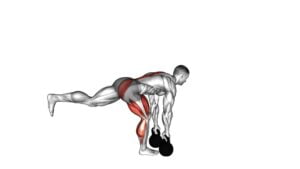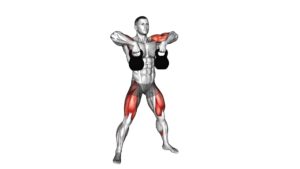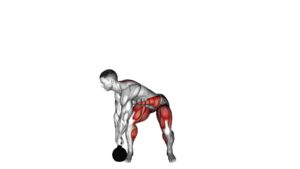Kettlebell Deadlift – Video Exercise Guide & Tips

In this article, you'll discover the benefits of the kettlebell deadlift.
Watch This Exercise Video
Watch the video exercise guide and learn the proper form and technique to avoid common mistakes.
With variations for different fitness levels and tips for maximizing results, you can take your deadlifts to the next level.
Just remember to follow safety precautions and warnings for a safe and effective workout.
Get ready to strengthen your muscles and improve your overall fitness with the kettlebell deadlift.
Key Takeaways
- Kettlebell deadlifts activate multiple muscle groups including glutes, hamstrings, quadriceps, and lower back.
- Kettlebell deadlifts strengthen and tone the glutes, leading to improved performance in other exercises.
- Kettlebell deadlifts develop the hamstrings, enhancing lower body strength and stability.
- Kettlebell deadlifts improve grip strength through constant engagement of hands and forearm muscles.
Benefits of Kettlebell Deadlifts
The kettlebell deadlift offers a multitude of benefits for you to reap. One of the major weightlifting benefits of this exercise is the muscle activation it provides. When performing the kettlebell deadlift, several muscle groups are activated, including the glutes, hamstrings, quadriceps, and lower back. These muscles work together to lift the kettlebell off the ground and bring it back down in a controlled manner.
The glutes, in particular, play a significant role in this exercise. They're responsible for hip extension, which is essential for lifting the kettlebell. By engaging the glutes during the deadlift, you can strengthen and tone these muscles, leading to improved performance in other exercises and everyday activities.
Another muscle group that benefits from the kettlebell deadlift is the hamstrings. These muscles are located at the back of the thighs and are crucial for hip extension and knee flexion. By regularly incorporating the deadlift into your workouts, you can strengthen and develop your hamstrings, which can enhance your overall lower body strength and stability.
In addition to muscle activation, the kettlebell deadlift also helps improve your grip strength. Since you're holding onto the kettlebell throughout the exercise, your hands and forearm muscles are constantly engaged. Over time, this can lead to increased grip strength, making it easier for you to perform other weightlifting exercises and activities that require a strong grip.
Proper Form and Technique
To perform the kettlebell deadlift with proper form and technique, you need to focus on maintaining a strong and stable position throughout the movement. Proper alignment is crucial to ensure that you engage the correct muscles and minimize the risk of injury.
Start by standing with your feet hip-width apart, toes pointing forward. Place the kettlebell on the ground between your feet, ensuring it's centered. Bend your knees and hinge at the hips, keeping your back flat and chest lifted. Grab the kettlebell with both hands, maintaining a firm grip.
As you begin the movement, exhale and brace your core. Keep your spine neutral and avoid rounding your back. Drive through your heels and engage your glutes and hamstrings as you lift the kettlebell off the ground. Keep your shoulders pulled back and down, and maintain a proud chest throughout the exercise.
Remember to breathe throughout the movement. Inhale as you lower the kettlebell back down, and exhale as you lift it up. This breathing technique helps to stabilize your core and maintain proper form.
Common Mistakes to Avoid
When performing the kettlebell deadlift, be mindful of common mistakes that can hinder your form and results. Proper technique is crucial for maximizing the effectiveness of this exercise and minimizing the risk of injury.
One common mistake is rounding your back during the lift. This can put excessive strain on your spine and lead to back pain. To avoid this, focus on keeping your back straight and your chest up throughout the movement.
Another mistake is using your arms to lift the kettlebell instead of relying on your legs and hips. This not only reduces the effectiveness of the exercise but also increases the risk of straining your biceps or shoulders. Instead, engage your glutes, hamstrings, and quads to initiate the movement.
Lastly, be cautious not to lift too heavy of a weight that compromises your form. It's better to start with a lighter weight and gradually increase as you become more comfortable and confident with your technique.
By being aware of these common mistakes and practicing proper form, you can optimize your kettlebell deadlift and achieve better results.
Now, let's explore variations for different fitness levels.
Variations for Different Fitness Levels
Now let's explore the different variations of the kettlebell deadlift that cater to different fitness levels.
Whether you're a beginner looking for modifications, an intermediate wanting to progress, or an advanced individual seeking a challenge, there are options for everyone.
Beginner Modifications for Kettlebell
Start with a lighter kettlebell weight to modify the exercise for beginners. When starting out with kettlebell deadlifts, it's important to make beginner modifications to ensure proper form and prevent injury.
Safety precautions should be taken into account to create a safe and effective workout routine. Begin by selecting a kettlebell that's appropriate for your fitness level. It's recommended to start with a lighter weight until you become comfortable and confident with the movement. Focus on maintaining a neutral spine throughout the exercise and engage your core muscles.
Keep your feet shoulder-width apart and grip the kettlebell with both hands, keeping your arms straight and shoulders pulled back. As you lower the kettlebell to the ground, hinge at the hips and bend your knees slightly.
Remember to always listen to your body and progress gradually to avoid overexertion.
Intermediate Progressions for Deadlift
To progress from the beginner modifications, you can incorporate intermediate variations of the kettlebell deadlift to challenge different fitness levels. These advanced modifications will help you continue to build strength and improve your deadlift technique. However, before attempting these variations, it's crucial to warm up properly to prevent injury.
Here are three intermediate progressions for the kettlebell deadlift:
- Single-Leg Deadlift: This variation focuses on unilateral strength and stability. Stand on one leg while holding the kettlebell in one hand, and slowly hinge at the hips, lowering the kettlebell towards the ground. Keep your core engaged and maintain a neutral spine throughout the movement.
- Sumo Deadlift: In this variation, you'll take a wider stance with your feet turned out at approximately 45 degrees. Hold the kettlebell with both hands between your legs and perform the deadlift movement with the same technique as the standard deadlift.
- Deficit Deadlift: For this variation, you'll elevate your feet on a step or platform, creating a deficit between your feet and the kettlebell. This increased range of motion challenges your strength and flexibility.
Incorporating these intermediate variations into your kettlebell deadlift routine will help you continue to progress and improve your overall strength and fitness level. Remember to always warm up properly before attempting these advanced modifications to prevent injury and optimize your performance.
Advanced Challenges for Fitness
To challenge yourself at different fitness levels, incorporate advanced variations of the kettlebell deadlift. These advanced modifications will push your limits and help you achieve greater strength and muscle gains.
One advanced training technique is the single-leg kettlebell deadlift, which requires balance and stability while lifting the kettlebell with one leg off the ground.
Another advanced modification is the kettlebell suitcase deadlift, where you hold the kettlebell by your side instead of between your legs. This variation increases the demands on your core and grip strength.
Additionally, you can try the kettlebell sumo deadlift, which involves a wider stance and targets your inner thighs and glutes.
These advanced challenges will take your kettlebell deadlift to the next level, providing you with more intensity and variety in your workouts.
Tips for Maximizing Results
Maximize your results by focusing on proper form and gradually increasing the weight of your kettlebell. When it comes to the kettlebell deadlift, following these tips will help you maximize gains and improve your performance:
- Engage your core: Before you even lift the kettlebell, make sure to engage your core muscles. This will help stabilize your spine and protect your lower back during the movement. Keep your abs tight and your back straight throughout the exercise.
- Hinge at the hips: The kettlebell deadlift is a hip-dominant exercise, so it's important to focus on hinging at the hips rather than bending at the waist. Push your hips back as you lower the kettlebell, maintaining a slight bend in your knees. This will engage your glutes and hamstrings, maximizing the effectiveness of the exercise.
- Gradually increase weight: As you become more comfortable with the kettlebell deadlift and start to see improvements in strength and form, gradually increase the weight of your kettlebell. This will challenge your muscles and help you continue to make progress over time.
Safety Precautions and Warnings
To ensure your safety while performing the kettlebell deadlift, it's crucial to maintain proper form.
This exercise requires a demonstration of correct technique to prevent common injuries.
Proper Form Demonstration
Follow these safety precautions and warnings when performing the kettlebell deadlift to ensure proper form and prevent injury.
- Maintain a neutral spine: Keep your back straight and avoid rounding or arching it during the movement. This will help distribute the load evenly and prevent strain on your lower back.
- Engage your core: Tighten your abdominal muscles throughout the exercise to provide stability and support to your spine.
- Start with lighter weights: Begin with a kettlebell that you can comfortably lift and control. Gradually increase the weight as your strength and technique improve.
Remember, proper form is crucial for maximizing the benefits of the kettlebell deadlift and reducing the risk of injury. Avoid common misconceptions such as using momentum or lifting with your back.
Common Injury Prevention
Continue to prioritize your safety and prevent injuries by following these additional safety precautions and warnings when performing the kettlebell deadlift.
To minimize the risk of injury, it's crucial to incorporate proper injury prevention techniques into your workout routine.
Before starting any exercise, including the kettlebell deadlift, always warm up your body to prepare it for the physical demands. A thorough warm-up increases blood flow, raises your core temperature, and loosens up your muscles, reducing the likelihood of strains and sprains.
Additionally, it's essential to maintain proper form and technique throughout the exercise. Keep your back straight, engage your core, and avoid rounding your shoulders.
Never lift a weight that's too heavy for you, as this can lead to muscle strains or even more serious injuries.
Frequently Asked Questions
How Many Reps and Sets Should I Do When Performing Kettlebell Deadlifts?
When performing kettlebell deadlifts, it's important to consider the recommended weight, proper form, as well as the number of reps and sets.
The recommended weight will vary depending on your fitness level and goals. It's generally recommended to start with a weight that challenges you but still allows for proper form.
As for the number of reps and sets, it's suggested to begin with 3-4 sets of 8-12 reps, gradually increasing the weight and intensity as you progress.
Can Kettlebell Deadlifts Help Improve My Posture?
Kettlebell deadlifts can definitely help improve your posture. By engaging the muscles in your back, glutes, and core, this exercise promotes proper alignment and stability throughout your entire body.
The benefits go beyond just posture, as kettlebell deadlifts also enhance overall body strength and stability.
To ensure optimal results and prevent injury, it's important to maintain proper form and technique. Remember to keep your back straight, engage your core, and lift with your legs.
Are Kettlebell Deadlifts Suitable for Beginners?
Yes, kettlebell deadlifts are suitable for beginners. They're a great exercise to start building strength and improving your posture. By incorporating kettlebell deadlift variations into your routine, you can target different muscles and increase the challenge as you progress.
However, it's important to learn the proper form and avoid common mistakes in kettlebell deadlifts, such as rounding your back or lifting with your arms. Consult with a trainer or watch instructional videos to ensure you're performing the exercise correctly.
Can Kettlebell Deadlifts Help Strengthen My Core?
Kettlebell deadlifts are a great exercise to strengthen your core. By incorporating different variations of kettlebell deadlifts into your routine, you can target various muscles in your core, such as your abs, obliques, and lower back.
These exercises require proper form and technique to maximize the benefits. The kettlebell deadlifts engage multiple muscle groups, improving your overall strength and stability.
What Are Some Alternative Exercises to Kettlebell Deadlifts for Targeting Similar Muscle Groups?
Looking for alternative exercises to target similar muscle groups as kettlebell deadlifts?
There are a few options you can consider.
One option is the barbell deadlift, which also works the glutes, hamstrings, and lower back.
Another alternative is the Romanian deadlift, which focuses on the hamstrings and glutes.
Additionally, the trap bar deadlift is another exercise that targets similar muscle groups.
Each of these exercises offers its own unique benefits and can be a great addition to your workout routine.
Conclusion
In conclusion, the kettlebell deadlift is a highly effective exercise for improving strength and overall fitness. By utilizing proper form and technique, individuals can reap the benefits of this exercise while minimizing the risk of injury.
It's important to avoid common mistakes and choose variations that suit your fitness level. By following these tips and precautions, you can maximize your results and ensure a safe workout experience.
Start incorporating the kettlebell deadlift into your fitness routine and enjoy the benefits it has to offer.

Author
Years ago, the spark of my life’s passion ignited in my mind the moment I stepped into the local gym for the first time. The inaugural bead of perspiration, the initial endeavor, the very first surge of endorphins, and a sense of pride that washed over me post-workout marked the beginning of my deep-seated interest in strength sports, fitness, and sports nutrition. This very curiosity blossomed rapidly into a profound fascination, propelling me to earn a Master’s degree in Physical Education from the Academy of Physical Education in Krakow, followed by a Sports Manager diploma from the Jagiellonian University. My journey of growth led me to gain more specialized qualifications, such as being a certified personal trainer with a focus on sports dietetics, a lifeguard, and an instructor for wellness and corrective gymnastics. Theoretical knowledge paired seamlessly with practical experience, reinforcing my belief that the transformation of individuals under my guidance was also a reflection of my personal growth. This belief holds true even today. Each day, I strive to push the boundaries and explore new realms. These realms gently elevate me to greater heights. The unique combination of passion for my field and the continuous quest for growth fuels my drive to break new ground.







